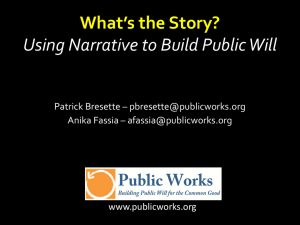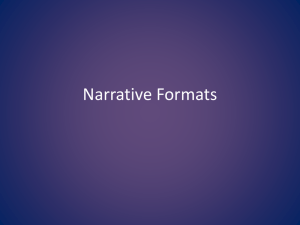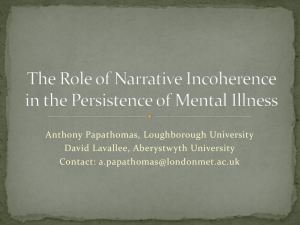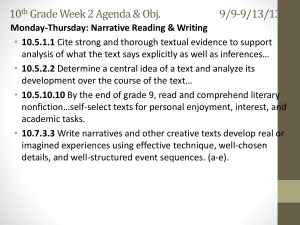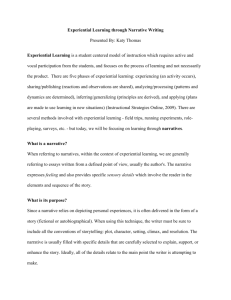Narrative Gerontology
advertisement
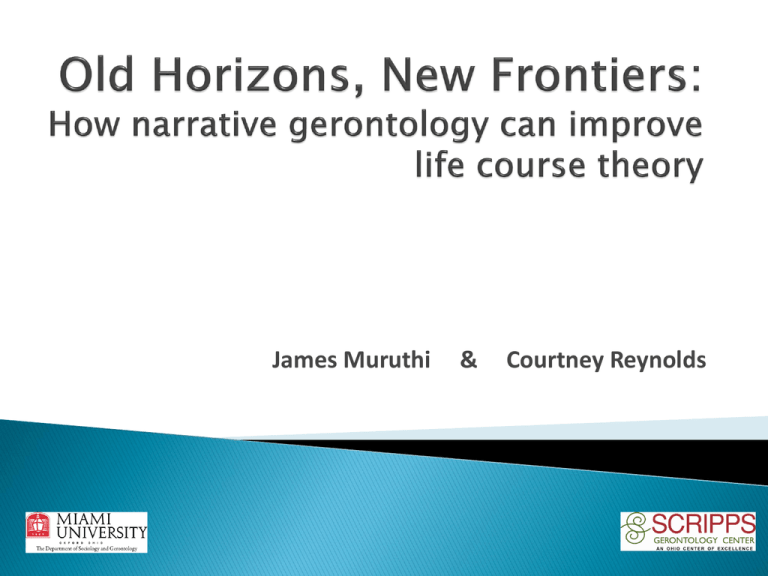
James Muruthi & Courtney Reynolds Narrative Gerontology Studying aging by obtaining critical events as told by and the older adult (Kenyon and Randall, 2001) “I have read several of the stories and enjoyed them because they paint such a nice, detailed picture of the person. It gives you another angle as to who (the residents are).” Source: Enriching now with then: Connecting nursing home residents and Staff through oral history by Mike Payne (2011) Highlights personal meaning and perceptions of social concepts Transmits cultural values, beliefs, practices and more Important for gerontologists to conceptualize their data to create inclusive theories Individuals tell and live their stories Stories consist of facts and potentiality (ability to change in different contexts) Narratives are multidimensional and dynamic Narratives do not provide absolute truths • • • • • • • • • Structure of committed or unique time. Generic particularity, they all fall in some genre or group (myths, legends, or folktales). Individuals’ actions have reasons. Empirical or rational evidence for actions. Authenticated within a given context. References in a narrative tend to be ambiguous. Centrality of trouble – common theme; fixing problems. Stories’ importance, meaning, and relevance can be contested. Stories follow certain temporal order. May lack structure Tend to lack social content, social action, and social interaction May not be authentic representations • Examines age over periods of time • Emphasis on: • structural processes • time and timing/chronological age • linked lives • individual agency • Contextualizes a person’s life Narrative Gerontology Life Course Perspective 1. Humans simultaneously tell and live stories A. Provides one of the most “authentic” measures of the human experience. Narrative Gerontology 2. All narratives consist of facts and potentiality. Life Course Perspective B. Opportunity to explore how events have impacted the development of older adults. Narrative Gerontology 3. Narratives are multidimensional. ◦ Structural ◦ Social ◦ Cultural ◦ Personal Life Course Perspective C. Aggregation of many narratives may enable researchers to find structural and personal commonalities. Narrative Gerontology 4. Narratives do not provide us with any absolute truths. They explain part of a larger story. Life Course Perspective D. No story, and, therefore, no life is more or less important than any other. 1. Development of a method beyond literature reviews that allows researchers to compare and contrast narrative data from multiple samples 2. Continued globalization of the field. 3. Encourage gerontologists to continue to embrace narrative gerontology. Before we take your questions, we’d like to give a special thank you to: Dr. Jennifer Kinney, Miami University Dr. Robert Applebaum, Miami University Our classmates at Miami University All of you for joining us today! Bruner, J. S. (1996). The Culture of Education. Cambridge, MA: Harvard University Press. Kenyon, G. M., Ruth, J., & Mader, W. (1999). Elements of a Narrative Gerontology. In V. L. Bengston & K. Warner Schaie (Eds.). Handbook of Theories of Aging (pp.40-58). New York: Springer Publishing Company. Randall, W. L., Kenyon, G. M., Kenyon, G. M., & Randall, W. L. (2001). Ordinary wisdom: Biographical aging and the journey of life. Westport, Conn. [u.a.: Praeger.





